DeFAI full solution: How does AI unlock the potential of DeFi?

Reprinted from panewslab
03/20/2025·2MAuthor: Geng Kai, DFG
What is DeFAI?
Since its rapid expansion in 2020, decentralized finance (DeFi) has been the core pillar of the crypto ecosystem. While many new innovative protocols have been established, it has also led to an increase in complexity and fragmentation, making it difficult for even experienced users to navigate a large number of chains, assets and protocols.
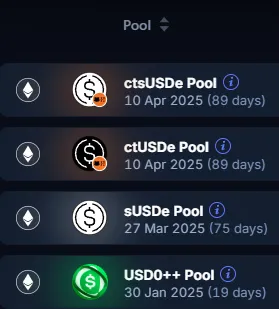
Meanwhile, artificial intelligence (AI) has evolved from a broad-based narrative in 2023 to a more professional, agency-oriented focus in 2024. This shift has spawned DeFi AI (DeFAI) – an emerging field where AI enhances DeFi through automation, risk management and capital optimization.
DeFAI spans multiple levels. Blockchain is the basic layer because AI agents must interact with specific chains to execute transactions and execute smart contracts. Above this, the data layer and computing layer provide the infrastructure needed to train AI models from historical price data, market sentiment, and on-chain analysis. The privacy and verifiable layer ensures sensitive financial data remains secure while remaining trustlessly executed. Finally, the proxy framework allows developers to build dedicated AI-driven applications such as autonomous trading bots, credit risk evaluators, and on-chain governance optimizers.

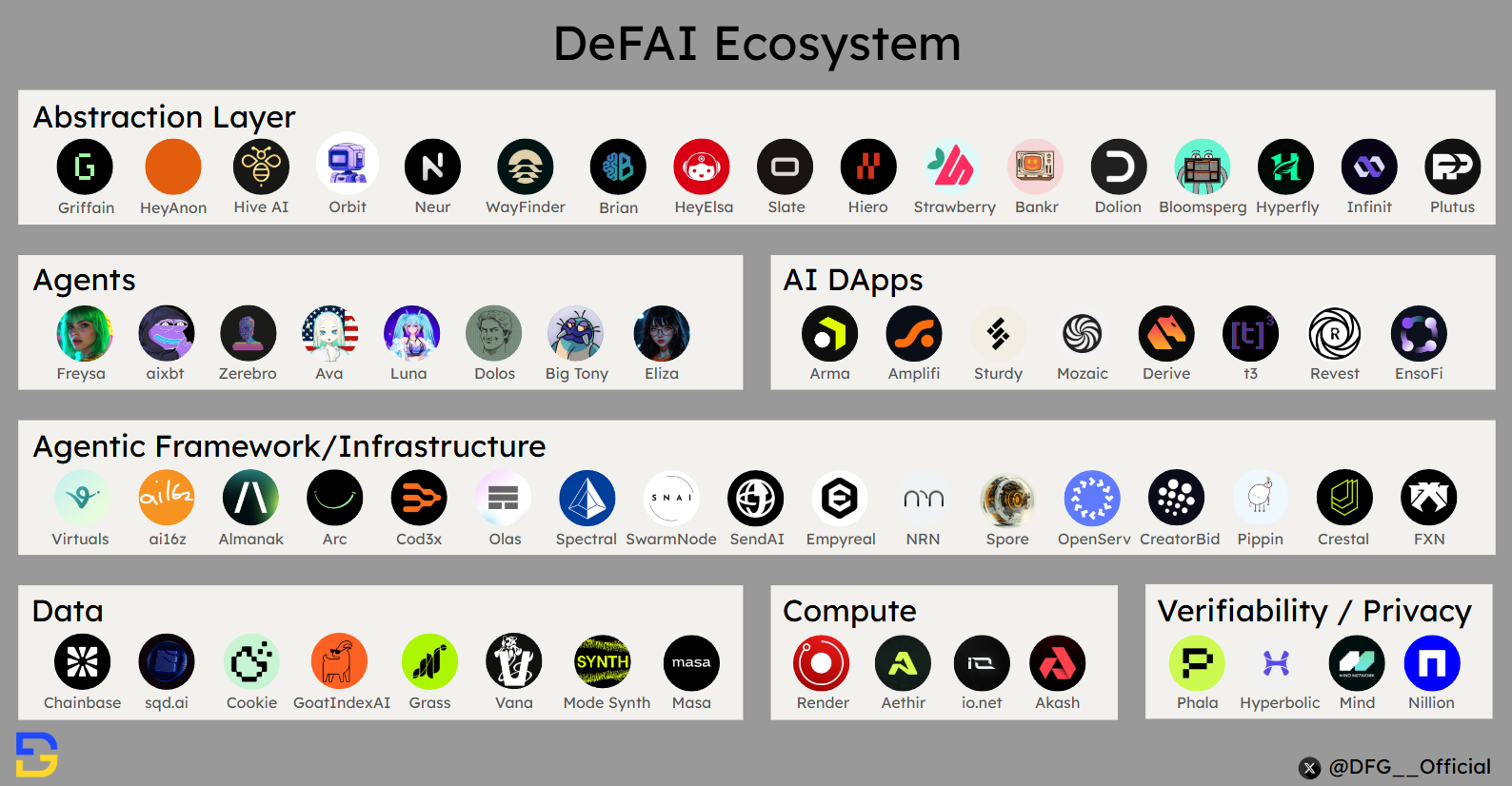
While this eco-map can be further expanded, these are the top categories of projects built on DeFAI.
As the DeFAI ecosystem continues to expand, the most prominent projects can be divided into three main categories:
1. Abstract layer
Establishing a protocol on this category acts as a ChatGPT-like user-friendly interface for DeFi, allowing users to enter prompts executed on the chain. They are often integrated with multiple chains and dApps and perform user intent while eliminating manual steps in complex transactions.
Some of the functions that these protocols can perform include:
-
Exchange, cross-chain, lending/withdrawal, cross-chain execution of transactions
-
Transaction wallet or Twitter/X profile
-
Automatically execute stop-win/stop-loss and other transactions based on the position size percentage
For example, there is no need to manually extract ETH from Aave, cross-chain it to Solana, exchange SOL/Fartcoin, and provide liquidity on Raydium—the abstraction layer protocol can do it in just one step.
Main Agreement:
-
@griffaindotcom — A proxy network that performs transactions for users
-
@HeyAnanai — A protocol that handles user prompts for DeFi transactions and real-time insights
-
@orbitcryptoai — DeFi Interaction AI Partner
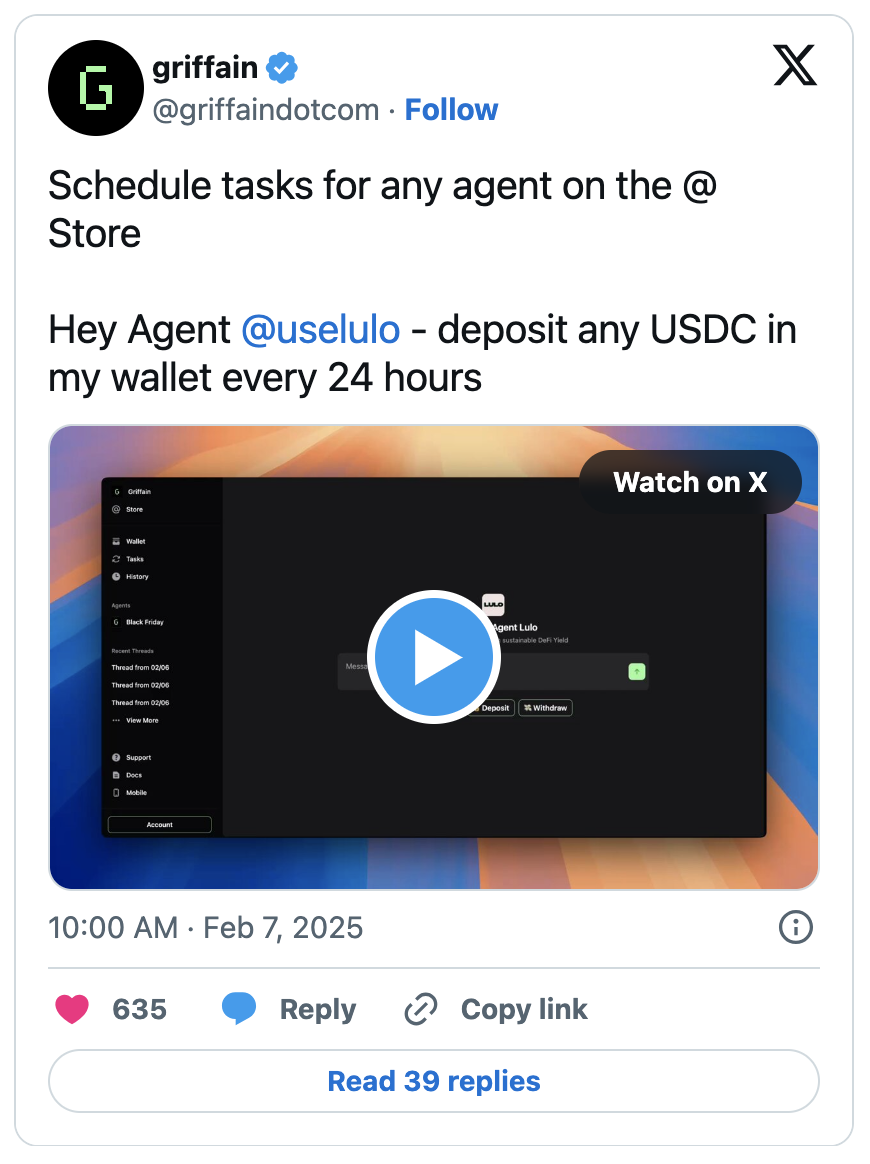
https://x.com/griffaindotcom/status/1887682734027645055
2. Independent transaction agent
Unlike traditional trading robots that follow preset rules, autonomous trading agents can learn and adapt to market conditions and adjust their strategies based on new information. These agents can:
-
Analyze data to continuously improve strategies
-
Forecast market trends to make better long/short decisions
-
Execute complex DeFi strategies like basic transactions
Main Agreement:
-
@Almanak__ — A platform for training, optimization and deployment of autonomous financial agents
-
@Cod3xOrg — Launches AI Agents that perform financial tasks on blockchain
-
@Spectral_Labs — Create a network of transaction agents on the autonomous chain
3. AI-powered DApps
DeFi dApp provides functions such as lending, exchange, and income farming. AI and AI agents can enhance these services in the following ways:
-
Optimize liquidity supply by rebalancing LP positions for better APY
-
Scan the tokens to discover risks by detecting potential rugs or honeypots
Main Agreement:
-
@gizatechxyz 's ARMA—AI proxy for optimizing USDC benefits in Mode and Base
-
@SturdyFinance — AI-driven income vault
-
@derivexyz — Options and Perpetual Contract Platform Optimized with Intelligent AI co-pilot
Key Challenges
Top protocols built on these layers face some challenges:
-
These protocols rely on real-time data streams for optimal transaction execution. Poor data quality can lead to inefficiency in routes, failure in transactions or unprofitable transactions
-
AI models rely on historical data, but the cryptocurrency market is highly volatile. Agents must be trained on diverse, high-quality datasets to remain effective
-
You need to have a comprehensive understanding of asset correlation, liquidity changes and market sentiment to understand the overall market situation
Agreements based on these categories have been welcomed by the market. However, in order to provide better products and best results, they should consider integrating a variety of data sets of different qualities to take their products to the next level.
Data layer – Powering DeFAI intelligence
The quality of an AI depends on the data it depends on. In order for AI agents to work effectively in DeFAI, they require real-time, structured and verifiable data. For example, the abstraction layer needs to access on-chain data through RPC and social network APIs, while the transaction and earnings optimization agent needs data to further refine its trading strategies and redistribute resources.
High-quality data sets enable agents to better predictive analytics of future price behavior, advising transactions to adapt their preference for long or short positions in certain assets.

DeFAI's main data provider
protocol
|
detail
|
Function
---|---|---
Mode Synth
|
Synthetic data for financial forecasts
|
Capture the complete price change distribution for AI model prediction
Chainbase
|
Full-chain structured dataset
|
Provides AI-enhanced data for trading, forecasting and obtaining alpha
sqd.ai
|
Decentralized data lake for AI agents
|
Scalable, customizable multi-chain data access with zero-knowledge proof security
Cookies
|
CT mind and on-chain data layer for AI agents
|
Use 18 dedicated AI agents to process over 7TB of on-chain proxy data on more than 20 chains
Mode Synth Subnet
As Bittensor's 50th subnet, Synth creates synthetic data for the agent's financial forecasting capabilities. Compared with other traditional price prediction systems, Synth captures the complete distribution of price movements and its associated probabilities, thus building the world's most accurate synthetic data to power agents and LLMs.
Providing more high-quality data sets allows AI agents to make better directional decisions in transactions while predicting APY fluctuations under different market conditions so that liquidity pools can redistribute or extract liquidity when needed. Since the launch of the network, they have always had strong requirements from the DeFi team to integrate Synth data through their API.
The most popular AI proxy blockchain
In addition to building data layers for AI and agents, Mode also positions itself as a full-stack blockchain for DeFAI in the future. They recently deployed Mode Terminal, a co-pilot from DeFAI, for executing on-chain transactions via user prompts, which will be open to $MODE stakers.
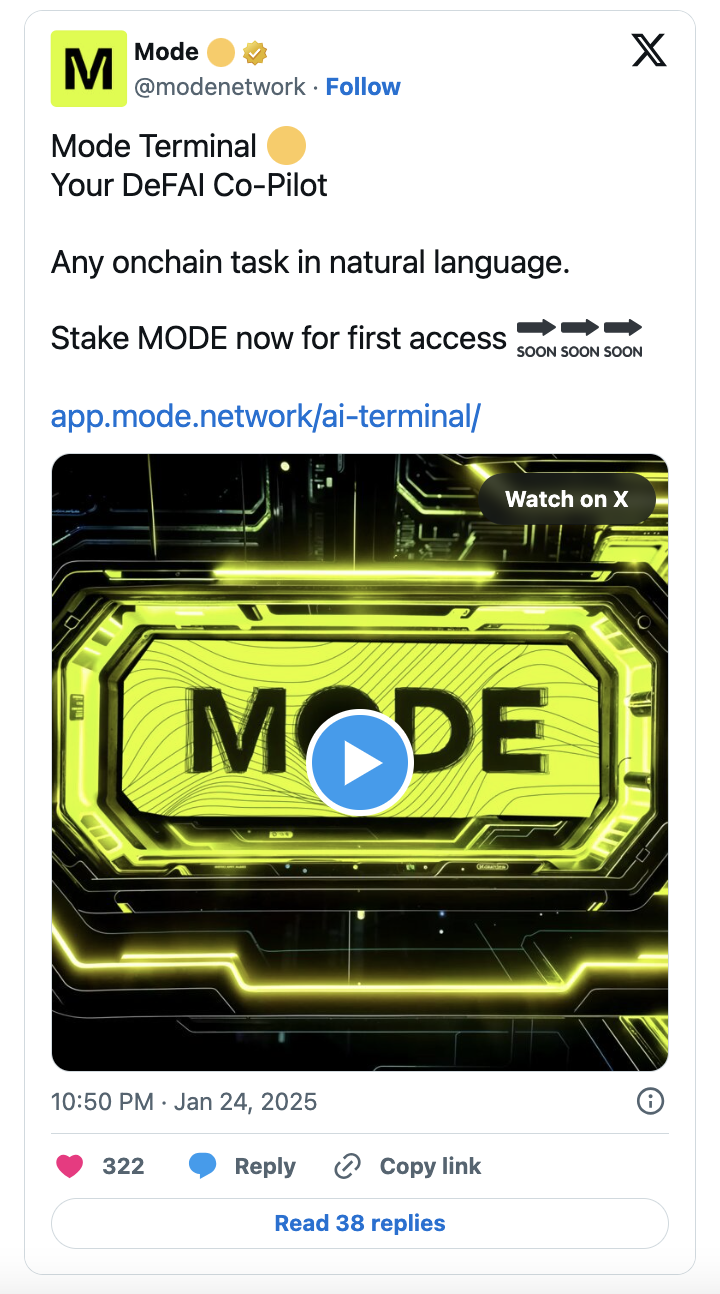
https://x.com/modenetwork/status/1882803123523383435?s=46&t=JaMReQ6LUFL_qJEJqpfTPw
In addition, Mode supports many AI-based and proxy-based teams. Mode has made great efforts to integrate protocols such as Autonolas, Giza, Sturdy into its ecosystem. Mode has developed rapidly as more agents develop and execute transactions.
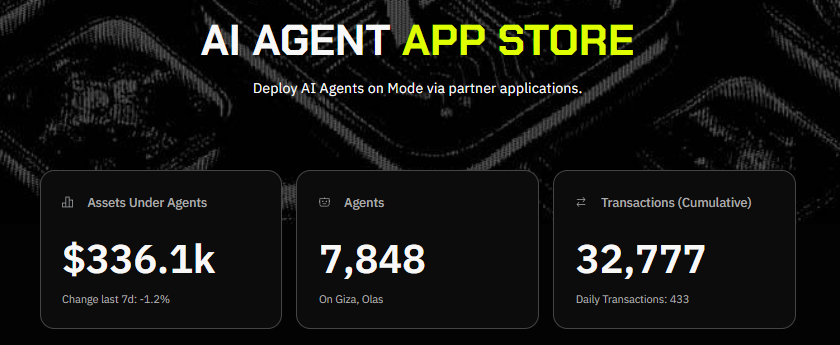
These initiatives are implemented while they upgraded their network with AI, most notably equipped with an AI sorter for their blockchain. By using simulation and AI to analyze transactions before execution, high-risk transactions can be blocked and reviewed before processing to ensure on-chain security. As the L2 of the Optimism hyperchain, Mode stands in the middle, connecting humans and proxy users with the best DeFi ecosystem.
Comparison of top-level blockchains based on AI agents
Solana and Base are undoubtedly the two main chains for most AI proxy frameworks and token building and publishing . AI agents utilize Solana's high throughput and low latency networks and open source ElizaOS to deploy proxy tokens, while Virtuals acts as launchpads for deploying proxy on Base. Although they all have hackathons and funding incentives, they haven't reached the level that Mode has achieved in terms of their AI initiatives as a chain.
NEAR previously defined itself as an AI-centric L1 blockchain, whose capabilities include the AI task market , the NEAR AI Research Center with an open source AI proxy framework, and the NEAR AI Assistant . They recently announced a $20 million AI Agent Fund for scaling fully autonomous and verifiable agents on NEAR.
Chainbase
Chainbase provides a full-chain verifiable on-chain structured data set, which can enhance AI agents' transactions, insights, predictions, alpha search and other functions. They launched manuscripts , a blockchain data flow framework for integrating on-chain and off-chain data into the target data store for unlimited queries and analysis.

This enables developers to customize data processing workflows to their specific needs. Standardizing and processing raw data into a clean, compatible format ensures that its dataset meets the stringent requirements of the AI system, reducing preprocessing time while improving model accuracy and helping create reliable AI agents.
Based on its extensive on-chain data, they also developed a model called Theia , which translates on-chain data into user data analysis without any complex coding knowledge. Chainbase’s data utility is evident in their partnership, where AI protocols are using their data to:
-
ElizaOS proxy plug-in for on-chain driver decision making
-
Building Vana AI Assistant
-
Flock.io social network intelligence, providing user behavior insights
-
Theoriq's data analysis and prediction of DeFi
-
Also collaborates with 0G, Aethir and io.net
Compared with traditional data protocols
Data protocols such as The Graph, Chainlink, and Alchemy provide data, but are not AI-centric. The Graph provides a platform for querying and indexing blockchain data, providing developers with access to raw data that is not built for transactions or policy execution. Chainlink provides oracle data feeds, but lacks AI-optimized data sets for prediction, while Alchemy mainly provides RPC services.
Chainbase data, by contrast, is specially prepared blockchain data that can be easily used by AI applications or agents in a more structured and insightful form, allowing agents to more easily obtain data related to on-chain market, liquidity and token data.
sqd.ai
sqd.ai (formerly Subsquid) is developing an open database network tailored for AI agents and Web3 services. Their decentralized data lakes provide permissionless, cost-effective access to large amounts of real-time and historic blockchain data, allowing AI agents to run more efficiently.
sqd.ai provides real-time data indexing (including indexes of unfinished blocks), with indexing speeds up to 150,000+ blocks per second, faster than any other indexer. They have provided more than 11TB of data over the past 24 hours , meeting the high throughput needs of billions of autonomous AI agents and developers.
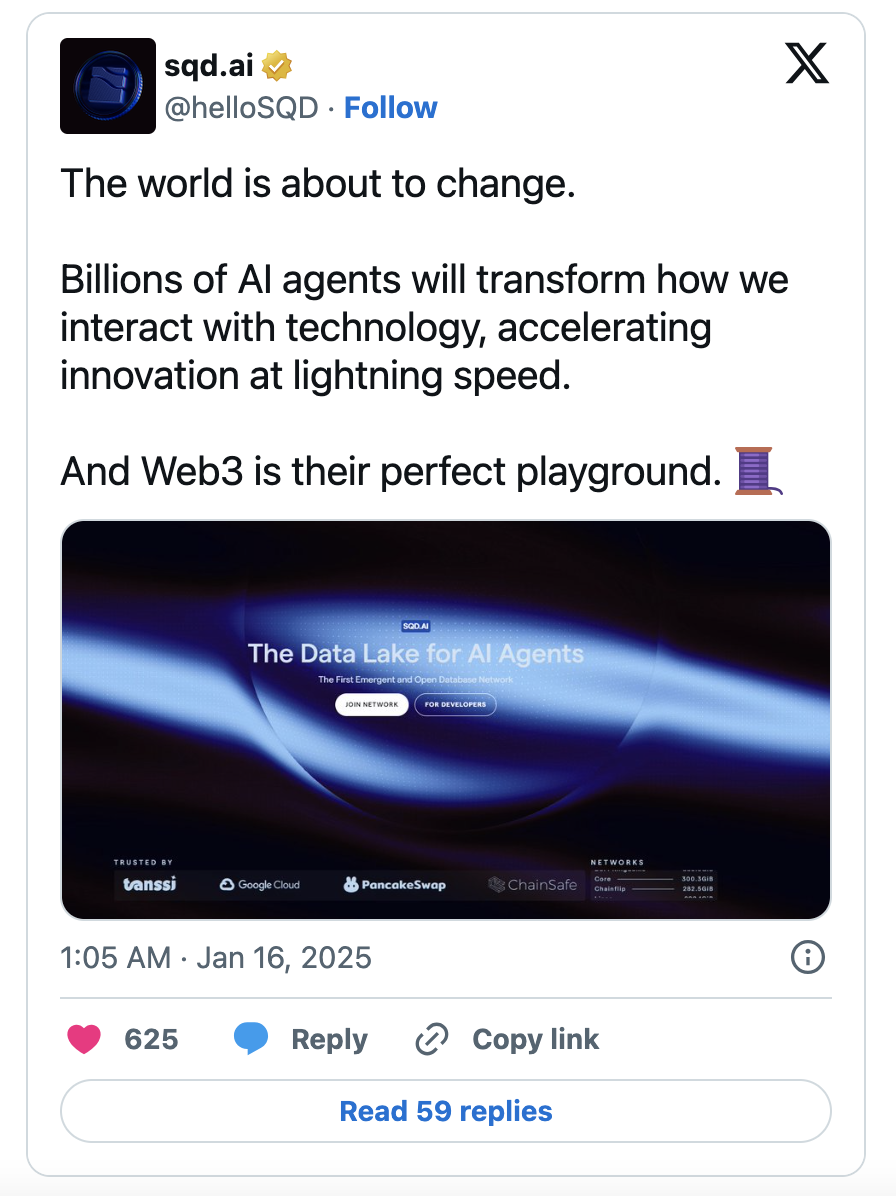
https://x.com/helloSQD/status/1879575591118414003
Their customizable data processing platform provides customized data to the needs of AI agents, while DuckDB provides efficient data retrieval for local queries. Their comprehensive dataset supports over 100 EVM and Substrate networks, including event logs and transaction details, which are valuable for AI agents running across multiple blockchains.
The addition of zero-knowledge proof ensures that AI agents can access and process sensitive data without compromising privacy. Additionally, sqd.ai can handle the increasing data load by adding more processing nodes, thus supporting a growing number of AI agents (estimated to reach billions).
Cookies
Cookies provide modular data layers for AI agents and clusters, specifically used to process social data. It has an AI proxy dashboard that tracks top proxy minds on-chain and social platforms, and recently launched a plug-and-play data cluster API for other AI proxy to detect popular narratives and mental shifts in CT.
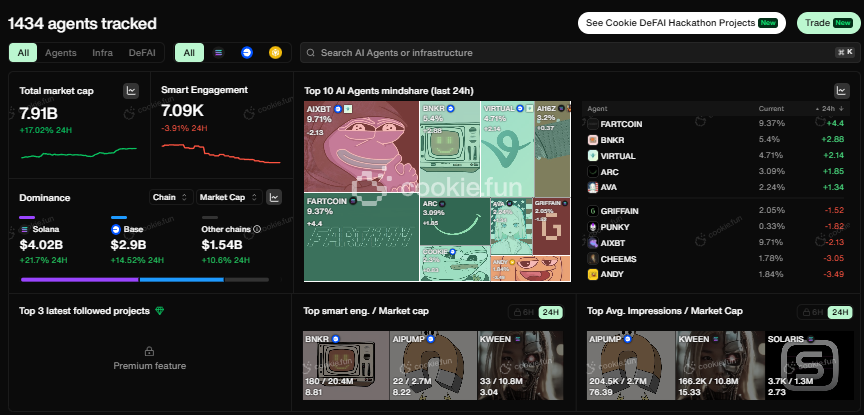
Their data cluster covers over 7TB of real-time on-chain and social data sources, powered by 20 data agents, providing insights into market sentiment and on-chain analytics. Their latest AI agent, @agentcookiefun , leverages their data cluster at 7% capacity, providing market forecasts and discovering new opportunities by leveraging various other agents running under it.
The next step for DeFAI
Currently, most AI agents in DeFi face significant restrictions in achieving complete autonomy. For example:
-
The abstraction layer converts user intentions into execution, but usually lacks prediction capabilities.
-
AI agents may generate alpha through analysis, but lack independent transaction execution
-
AI-powered dApps can handle vaults or transactions, but are passive rather than active
The next phase of DeFAI may focus on integrating useful data layers to develop the best proxy platform or proxy. This will require deep on-chain data about giant whale activity, liquidity changes, etc., while generating useful synthetic data for better predictive analysis, combined with sentiment analysis from general markets, whether it is token fluctuations in specific categories (such as AI agents, DeSci, etc.) or token fluctuations on social networks.
The ultimate goal is that AI agents can seamlessly generate and execute transaction strategies from a single interface. As these systems mature, we may see future DeFi traders rely on AI agents to independently evaluate, predict and execute financial strategies with minimal human intervention.
The final thought
Given the sharp shrinkage of AI proxy tokens and frameworks, some may think that DeFAI is just a flash in the pan. However, DeFAI is still in its early stages, and the potential of AI proxy to enhance DeFi availability and performance is undeniable.
The key to unlocking this potential is to acquire high-quality real-time data, which will improve AI-driven transaction forecasting and execution. More and more protocols integrate different data layers, and data protocols build plugins for the framework, which highlights the importance of data to proxy decisions.
Going forward, verifiability and privacy will be key challenges that agreements must address. Currently, most AI proxy operations are still a black box, and users must entrust funds to it. Therefore, the development of verifiable AI decisions will help ensure transparency and accountability of agency processes. Integrating protocols based on TEE, FHE and even zk-proofs can enhance the verifiability of AI proxy behavior, thereby achieving trust in autonomy.
DeFAI agents can only be widely used if they are successfully combined with high-quality data, robust models and transparent decision-making processes.

